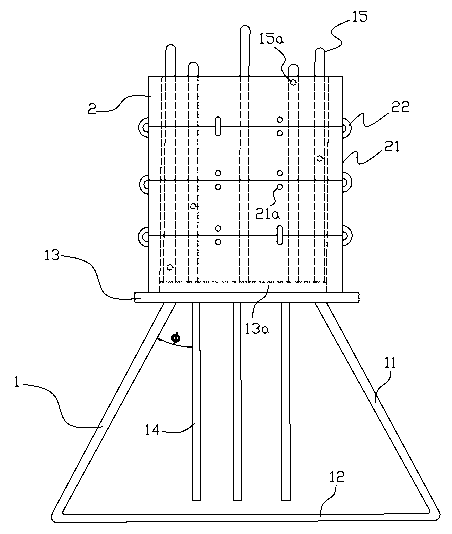Self-sinking fish reef
A self-sinking, fish reef technology, applied in fish farming, application, climate change adaptation, etc., can solve the problem that the population density can only be removed or destroyed, and the efficiency is not high
- Summary
- Abstract
- Description
- Claims
- Application Information
AI Technical Summary
Problems solved by technology
Method used
Image
Examples
Embodiment
[0012] Example: refer to figure 1 , a self-sinking fish reef, which has a self-sinking support 1; the self-sinking support 1 contains a platform 13; a trapezoidal support frame is provided below the platform 13; the support frame is connected by the side support rod 11 on the side and the bottom support rod 12 at the bottom; the platform 13 The lower portion located on the inner side of the side support rod 11 is provided with a limit column 14; the upper part of the platform 13 has an upwardly protruding positioning boss 13a; The combined reef body 2; the combined reef body 2 includes an annular reef 21 matched with the edge of the positioning boss 13a; the side position of the annular reef 21 near the top or bottom has a through positioning hole 21a capable of accommodating the pin 22. The bottom support rod 12 can be a rectangular structure composed of four, or a circular shape. The support frame will slowly sink on the seabed due to gravity, and will not become stable unt...
PUM
 Login to View More
Login to View More Abstract
Description
Claims
Application Information
 Login to View More
Login to View More - R&D
- Intellectual Property
- Life Sciences
- Materials
- Tech Scout
- Unparalleled Data Quality
- Higher Quality Content
- 60% Fewer Hallucinations
Browse by: Latest US Patents, China's latest patents, Technical Efficacy Thesaurus, Application Domain, Technology Topic, Popular Technical Reports.
© 2025 PatSnap. All rights reserved.Legal|Privacy policy|Modern Slavery Act Transparency Statement|Sitemap|About US| Contact US: help@patsnap.com

